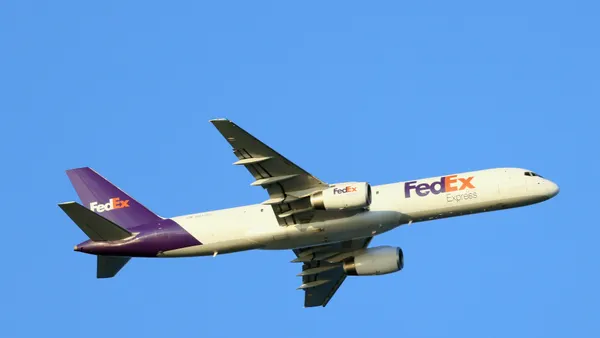Dive Brief:
- Airfreight volume fell 1.9% year-over-year (YoY) in February — the 15th straight month of declining volume, according to the latest numbers from the International Air Transport Association (IATA). In seasonally adjusted terms, demand fell by 9.1% month-over-month, which IATA called "the largest ever monthly decline for that series." February 2019 cargo volume was also relatively weak, which helps to explain the relatively small YoY decrease.
- Freight capacity fell 4.4% YoY in February, which is the first time capacity has contracted since February 2017. Flight cancellations from airlines in the Asia Pacific region drove the capacity reduction, IATA said.
- The February decreases in demand are largely the result of the coronavirus' impact on manufacturing in China, but future releases should highlight the extent to which the outbreak has disrupted air freight on a global scale, IATA noted.
Dive Insight:
Air cargo traffic on the Asia-North America trade lanes was down 2.4% year-on-year in February due to factory closures and bottlenecks at warehouses and airports in Asia, according to IATA. But with capacity down, airfreight rates are higher and those still looking to procure air freight must pay a premium.
The price to ship between China/Hong Kong and the United States has increased from $3.49 per kilogram on March 9 to $5.83 per kilogram on April 6 (a 67% increase), according to numbers from the TAC Index. Rates from Europe to the U.S. are also higher month-over-month.
"The industry is struggling to serve remaining demand with the limited capacity available," IATA CEO Alexandre de Juniac said in a statement.
Multiple passenger airlines have started cargo-only flights to account for the remaining demand.
FedEx Chief Marketing and Communications Officer Brie Carere spoke about the capacity cuts on an earnings call last month.
"Total air cargo capacity reduction to and from Mainland China from early February to early March is estimated at 40% year-over-year," Carere said. "Wide-body belly capacity contributed to 82% of this decline."
With passenger airlines canceling flights, cargo airlines like FedEx faced an "influx of shipment requests to China," which the carrier managed with peak surcharges and adjustments to transit commitments, she said.
"While the manufacturing has started to come back, the belly capacity on passenger airlines continue to be severely constrained," FedEx COO Raj Subramaniam said on the same call. "In contrast, FedEx flew 246 flights in and out of China just last week, which is aligned with our normal flight schedule and over in the past couple of weeks our flights have been full and we have registered record load factors intra-Asia, especially with our hub in Guangzhou."
But with manufacturing coming back online in China, factories are shutting down in Europe and North America, hurting demand for air cargo in those regions.















